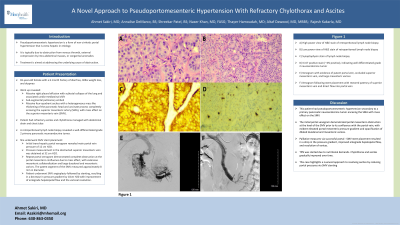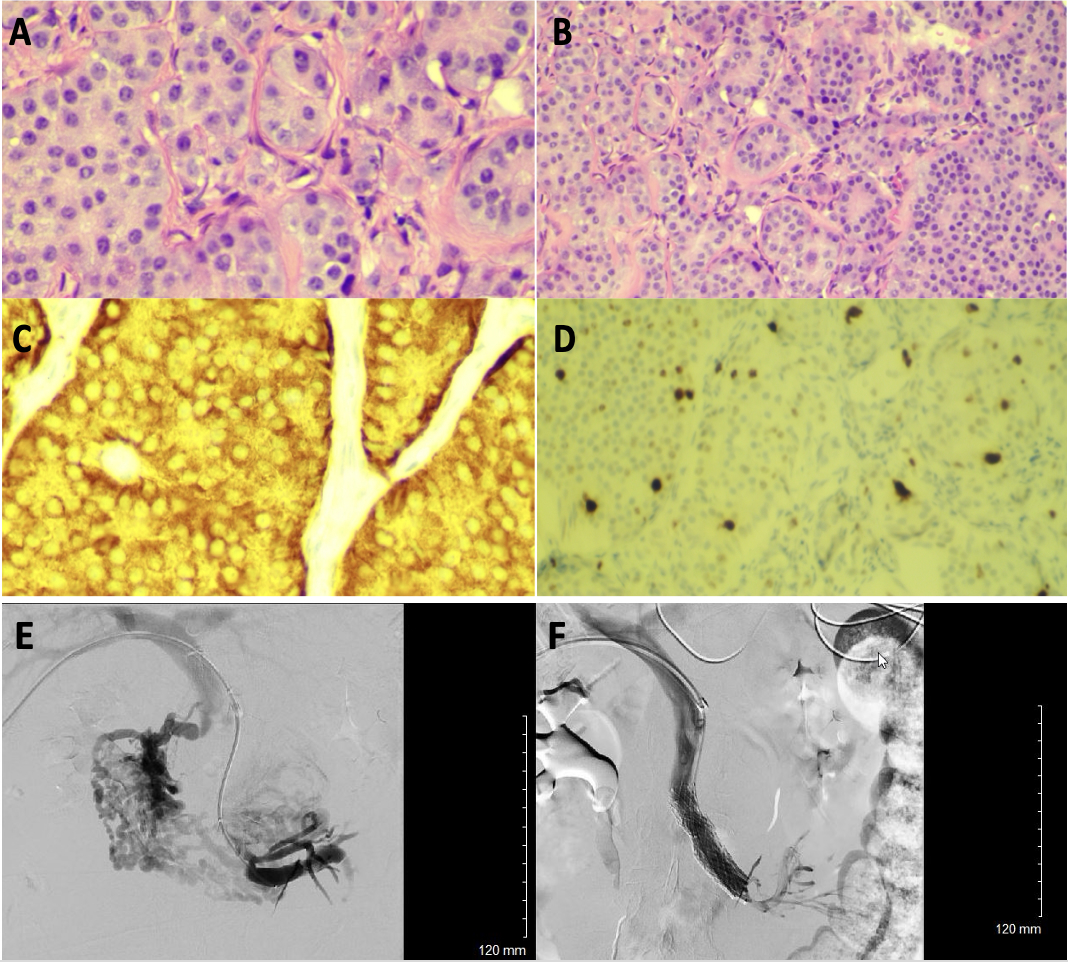Tuesday Poster Session
Category: Liver
P4810 - A Novel Approach to Pseudoportomesenteric Hypertension With Refractory Chylothorax and Ascites
Tuesday, October 29, 2024
10:30 AM - 4:00 PM ET
Location: Exhibit Hall E

Has Audio

Ahmet Sakiri, MD
Mercy Health
Rockford, IL
Presenting Author(s)
Ahmet Sakiri, MD, Annalise De Marco, BS, Shreekar Patel, BS, Naser Khan, MD, Thayer Hamoudah, MD, Altaf Dawood, MD, MBBS, Rajesh Kakarla, MD
Mercy Health, Rockford, IL
Introduction: Pseudoportomesenteric hypertension is a form of non-cirrhotic portal hypertension that is extra-hepatic in etiology, typically due to obstruction from venous thrombi, external compression by intra-abdominal masses, or congenital anomalies. Treatment is aimed at addressing the underlying cause of obstruction.
Case Description/Methods: We present a 65-year-old female with a 6 month history of diarrhea, 30lbs weight loss, and dyspnea. Work up revealed massive right pleural effusion with subtotal collapse of the lung and associated cardio-mediastinal shift, sub-segmental pulmonary emboli, and massive four-quadrant ascites with a heterogeneous mass like thickening of the pancreatic head and uncinate process completely encasing the superior mesenteric artery (SMA), with mass effect on the superior mesenteric vein (SMV. Patient was found to have refractory ascites and chylothorax. Patient underwent appropriate medical management along with chest tube placement abdominal drain. A retroperitoneal lymph node biopsy revealed a well-differentiated grade 2 primary pancreatic neuroendocrine tumor.
After a multidisciplinary assessment, patient underwent SMV stent placement. Initial trans-hepatic portal venogram revealed main portal vein pressure of 12 cm H2O. Pressure measurement in the obstructed superior mesenteric vein was obtained at 32 cm H2O. Repeat portal venogram demonstrated complete obstruction at the portal mesenteric confluence due to mass effect, with extensive mesenteric collateralization and large duodenal and mesenteric varices. The patent segment of the SMV measured approximately 8 mm in diameter. Patient underwent SMV angioplasty followed by stenting, resulting in a decrease in pressure gradient by 10cm H20 with improvement of antegrade hepatopetal flow and the variceal resolution.
Discussion: This patient had pseudoportomesenteric hypertension secondary to a primary pancreatic neuroendocrine tumor encasing the SMA with mass effect on the SMV. The initial portal venogram demonstrated portal mesenteric obstruction at the level of the SMV prior to its confluence with the portal vein, with evident elevated portal-mesenteric pressure gradient and opacification of dilated duodenal and mesenteric varices. Palliative measures via successful portal - SMV stent placement resulted in a drop in the pressure gradient, improved antegrade hepatopetal flow, and resolution of varices. TPN was started due to nutritional demands. Chylothorax and ascites gradually improved over time.

Disclosures:
Ahmet Sakiri, MD, Annalise De Marco, BS, Shreekar Patel, BS, Naser Khan, MD, Thayer Hamoudah, MD, Altaf Dawood, MD, MBBS, Rajesh Kakarla, MD. P4810 - A Novel Approach to Pseudoportomesenteric Hypertension With Refractory Chylothorax and Ascites, ACG 2024 Annual Scientific Meeting Abstracts. Philadelphia, PA: American College of Gastroenterology.
Mercy Health, Rockford, IL
Introduction: Pseudoportomesenteric hypertension is a form of non-cirrhotic portal hypertension that is extra-hepatic in etiology, typically due to obstruction from venous thrombi, external compression by intra-abdominal masses, or congenital anomalies. Treatment is aimed at addressing the underlying cause of obstruction.
Case Description/Methods: We present a 65-year-old female with a 6 month history of diarrhea, 30lbs weight loss, and dyspnea. Work up revealed massive right pleural effusion with subtotal collapse of the lung and associated cardio-mediastinal shift, sub-segmental pulmonary emboli, and massive four-quadrant ascites with a heterogeneous mass like thickening of the pancreatic head and uncinate process completely encasing the superior mesenteric artery (SMA), with mass effect on the superior mesenteric vein (SMV. Patient was found to have refractory ascites and chylothorax. Patient underwent appropriate medical management along with chest tube placement abdominal drain. A retroperitoneal lymph node biopsy revealed a well-differentiated grade 2 primary pancreatic neuroendocrine tumor.
After a multidisciplinary assessment, patient underwent SMV stent placement. Initial trans-hepatic portal venogram revealed main portal vein pressure of 12 cm H2O. Pressure measurement in the obstructed superior mesenteric vein was obtained at 32 cm H2O. Repeat portal venogram demonstrated complete obstruction at the portal mesenteric confluence due to mass effect, with extensive mesenteric collateralization and large duodenal and mesenteric varices. The patent segment of the SMV measured approximately 8 mm in diameter. Patient underwent SMV angioplasty followed by stenting, resulting in a decrease in pressure gradient by 10cm H20 with improvement of antegrade hepatopetal flow and the variceal resolution.
Discussion: This patient had pseudoportomesenteric hypertension secondary to a primary pancreatic neuroendocrine tumor encasing the SMA with mass effect on the SMV. The initial portal venogram demonstrated portal mesenteric obstruction at the level of the SMV prior to its confluence with the portal vein, with evident elevated portal-mesenteric pressure gradient and opacification of dilated duodenal and mesenteric varices. Palliative measures via successful portal - SMV stent placement resulted in a drop in the pressure gradient, improved antegrade hepatopetal flow, and resolution of varices. TPN was started due to nutritional demands. Chylothorax and ascites gradually improved over time.

Figure: A) High power view of H&E stain of retroperitoneal lymph node biopsy. B) Low power view of H&E stain of retroperitoneal lymph node biopsy. C) Synaptophysin stain of lymphnode biopsy. D) Ki-67 positive stain (~4% positive), indicating well differentiated grade 2 neuroendocrine tumor. E) Venogram with evidence of patent portal vein, occluded superior mesenteric vein, and large mesenteric varices. F) Venogram following stent placement with restored patency of superior mesenteric vein and direct flow into portal vein
Disclosures:
Ahmet Sakiri indicated no relevant financial relationships.
Annalise De Marco indicated no relevant financial relationships.
Shreekar Patel indicated no relevant financial relationships.
Naser Khan indicated no relevant financial relationships.
Thayer Hamoudah indicated no relevant financial relationships.
Altaf Dawood indicated no relevant financial relationships.
Rajesh Kakarla indicated no relevant financial relationships.
Ahmet Sakiri, MD, Annalise De Marco, BS, Shreekar Patel, BS, Naser Khan, MD, Thayer Hamoudah, MD, Altaf Dawood, MD, MBBS, Rajesh Kakarla, MD. P4810 - A Novel Approach to Pseudoportomesenteric Hypertension With Refractory Chylothorax and Ascites, ACG 2024 Annual Scientific Meeting Abstracts. Philadelphia, PA: American College of Gastroenterology.
